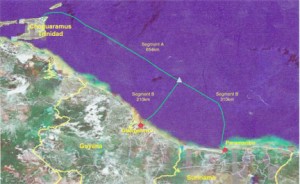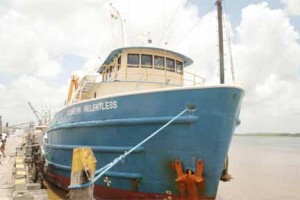All bandwidth needs will be taken care of
Possible Brazil link under discussion
As the Guyana Telephone and Telegraph Company (GT&T) continues to work towards its deadline of the second quarter of 2010 for the operationalizing of a new multi-million dollar fibre optic cable to service the country’s telecommunications sector, the company’s Chief

Executive Officer Major General (ret’d) Joe Singh has told Stabroek Business that the completion of the project will place the country’s Information and Communications Technology (ICT) sector on the threshold of a significant breakthrough.
GT&T and the Surinamese telecommunications company TELESUR are together investing US$60m in the manufacture and installation of the new Suriname-Guyana Submarine Cable System which will originate at Chaguaramas, in Trinidad and Tobago and will connect with cable stations in Georgetown and Totness in Suriname via a branching unit in the Atlantic.
The contractors, Global Marine Services Ltd. are expected to deliver a turnkey project which is expected to enter its testing phase in March next year prior to becoming operational.
Singh said that the local telecommunications company’s US$30m investment in the new cable system will, among other things, create the long-awaited additional and cheaper bandwidth that is critical to the expansion of the country’s ICT sector. “The cable will help realize everything that the President has been saying about a national ICT strategy, including the creation of an IT village, marketing Guyana as a destination for the establishment of Call Centres; retooling the system of administration using e-governance; dealing with and addressing issues like Distance Learning. All of these things will be facilitated because of the reliability, capacity, redundancy and affordability arising from the installation of the cable,” Singh said.
While the benefits of the new fibre optic cable could still be a year away, GT&T has already initiated a programme to sensitize both the public and private sectors to its potential to enable the enhanced application of IT to the various facets of national life. Last week, Singh and the company’s Director of Marketing Eustace Abrams were due to commence what is expected to be several rounds of meetings with local agencies. “What we will be telling them is that, from the second quarter of next year, we will have the capacity to satisfy all of their bandwidth requirements. We will also be undertaking a scoping exercise to determine what the current bandwidth needs of these agencies currently are and what they will be in the future. Additionally, we will be seeking to motivate those businesses that have potential for growth to plan on the basis that bandwidth will be available,” Singh told Stabroek Business.
According to Singh some local agencies have already begun to retool their IT infrastructure in anticipation of additional bandwidth capacity. “The people who are involved in our marketing know about the cable and its capacity. They will sit with the agencies and we expect them to tell us what it is that we can do to help them to position themselves in a competitive environment,” Singh added.

The complex logistical, manufacturing and installation processes that comprise full and final installation of the new fibre optic cable are unfolding both here in Guyana, in Trinidad and Tobago and in Europe. Three weeks ago a survey ship, The Relentless, was in Guyana to conduct what Singh described as a “close in shore survey” to ensure that when the cable is laid in the area of the beach there are no underwater or overwater obstacles that would impede its smooth running. This phase of the project is being carried out in collaboration with the Harbour Master, the local Maritime Authority, the Fisheries Department of the Ministry of Agriculture and the Coast Guard all of whom supported the survey. Singh said that the survey has been completed and that the results are to be delivered to GT&T after they have been analysed.
Singh said that the survey aspect of the project was aimed at reducing the kinds of vulnerabilities like ships’ anchors and fishermen’s stakes that have affected the existing Americas 11 cable from time to time. He said that the contractors are ensuring that they are in contact with all the agencies that need to be involved in order to reduce the element of risk to the cable. “The cable will benefit from an exclusive zone which allows its integrity to be assured,” Singh said.
Meanwhile, GT&T is also in discussions with the local Environmental Protection Agency (EPA) regarding the likely environmental impact of the project.
The cable is currently being built by a European company NEXAMS and continual inspections are being done to ensure that it satisfies the requirements of the project.
The full installation of the cable by March next year will be followed by a period of testing which, Singh said, “will seek to ensure the synchronization between the cable’s electronics and GT&T’s electronics as well as its integration with the circuitry in Suriname. He said that part of what the cable seeks to achieve is a “loop” that will provide “a built-in, self-healing redundancy so that if there is a cut between the branching unit and ourselves we can divert traffic through Suriname.”
Singh disclosed that GT&T is also undertaking the upgrading of the capacity of the existing Americas 11 cable so that it can be integrated with the new cable system.
Meanwhile, preparatory technical work including an offshore survey is currently taking place offshore Trinidad and Tobago since the cable will originate at Chaguaramas. “We selected Chaguaramas because Trinidad offers more backhaul options going to other countries from which there are several other incoming cables,” Singh said.
Singh told Stabroek Business that the cable also provides the capacity for additional telecommunications links between Guyana and the Brazilian states of Roraima and Amazonas. He said that in March this year GT&T had met with a senior representative of the Brazilian telecommunications company OI (formerly Brazilian Telecoms) in New York for “initial dialogue” on the prospects for having the service extended to Brazil, He said that GT&T had met in Georgetown, two weeks ago with a marketing representative of the company. ‘We have done a study of the options that are available to them outside of their borders and they have also presented their options based on a study that they did.” Singh said that while the studies show that there are options available to the Brazilians, a key factor would be the completion of the road link between Guyana and Brazil. He said that the rationale was that the laying of a cable over 400 kilometres as a “stand alone project” would not be feasible unless it is tied to some other major project such as the road link. “We hope that the completion of the Takutu Bridge will be a catalyst for serious consideration on the part of the Brazilians,” Singh said.





